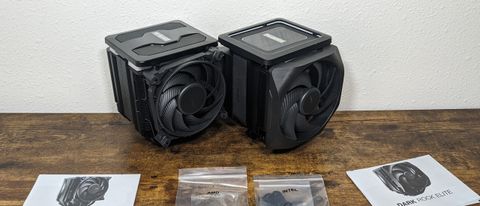Tom's Hardware Verdict
Be Quiet’s Dark Rock Pro V and Elite raise the bar for quiet cooling performance, offering the best performance from any low-noise coolers we’ve tested.
Pros
- +
The quietest high-end coolers we’ve tested
- +
Better thermal results than the Dark Rock Pro 4
- +
SFF compatible
Cons
- -
Expensive
Why you can trust Tom's Hardware
It’s been a long time since we’ve had any new air coolers from be quiet! (henceforth referred to as Be Quiet) on our test bench. We looked at the Dark Rock Pro 4 way back in 2018. The German company is well known among PC enthusiasts for its AIO and air cooling products, as well high-end computer cases like the Shadow Base 800 FX and Silent Base 802. Cooling enthusiasts have been waiting patiently for the successor to Be Quiet’s Dark Rock Pro 4, but they don’t have to wait any longer – today’s review will examine Be Quiet’s latest high-end air coolers, the Dark Rock Pro 5 and Dark Rock Elite. Since heatsinks on both are the same and the only differences are the fans and cover, we’re testing them both together.
Competition this year in air cooling has been fierce. Products like DeepCool’s Assassin IV and Thermalright’s Frost Commander 140 have raised our expectations for quality air cooling. Do the improvements made by Be Quiet’s engineers elevate the Dark Rocks’ performance enough to best its tough competition and earn a spot on our best coolers list? We’ll have to put it through our cooling and noise testing to find out. But first, here are the coolers’ specifications, direct from Be Quiet!
Cooler Specifications
| Cooler | Be Quiet! Dark Rock Pro V/Be Quiet! Dark Rock Elite |
| MSRP | $89.90/$99.90 |
| Heatsink Material | Aluminum |
| Rated Lifespan | >300,000 hours (for fans) |
| Socket Compatibility | Intel Socket LGA 115x/1200/1700 AMD AM5 / AM4 |
| Base | Nickel Plated Copper |
| Max TDP (Our Testing) on Intel’s i7-13700K | ~225W for Dark Rock Pro V, ~235W on Dark Rock Elite |
| Installed Size (with fans) | 145mm (L) x 136 mm (W) x 168mm (D) |
| Warranty | 3 years |
Features of the Dark Rock Pro V and Dark Rock Elite CPU Coolers
Solid black design, seven copper heatpipes
The Dark Rock Pro V and Elite CPU coolers both feature solid all-black designs, with seven copper heat pipes connected to dual towers for heat dissipation. The heatsinks on both units are exactly the same; the only differences are the fans and cover.
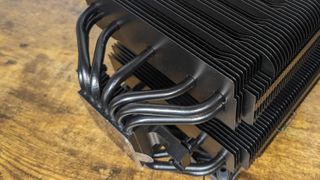
SFF Compatibility
Many of the largest air coolers won’t fit into space-constrained compact cases. While I can’t promise that the Dark Rock Pro V and Elite will fit into every case on the market, I was able to install it on my Ryzen 7700X SFF system using Silverstone’s SUGO 14 Min-ITX case – though the fit was very tight!

Magnetically Sealed Covers
Both coolers include magnetic covers for the tops of the unit. These hide the top of the heatpipes and the performance mode toggle, giving the coolers a slightly more pleasing look. The top of the Dark Rock Elite features an ARGB ring that can optionally be connected to a motherboard for controlling illumination.


Adjustable RAM compatibility
Out of the box, these coolers have RAM limitations of 42mm (1.65 inches). However, you can slide the fan up a few notches to accommodate latter RAM like the 45mm DDR4 GSkill sticks I use in my testing setup. The Dark Rock Elite also includes a fan brace, which can be slid up and down to easily adjust its position. The Dark Rock Pro V includes traditional fan clips, which are more fiddly.
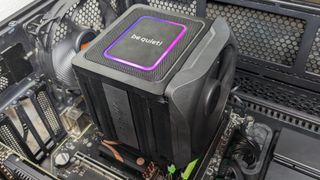
Middle Heatsink
In addition to the dual tower heatsinks, both coolers include a small heatsink in the middle of the unit to help move heat away from the CPU.

Silent Wings Fans
There’s more to a cooler than just the heatsink or radiator. The bundled fans significantly impact cooling and noise levels, as well as how the cooler looks in your case. The only real difference between the Dark Rock Pro 5 and the Dark Rock Elite is the fans – and as you’ll see in the benchmarks, this can make a serious impact on thermal performance!
Unfortunately, the specifications below provided by Be Quiet are lacking and don’t provide statistics traditionally included, like static pressure and airflow ratings – but ultimately, our noise and temperature measurements will tell how well the fans perform.
| Model | Silent Wings/Silent Wings 4 |
| Dimensions | 135 x 135 x 25 / 120 x 120 x 25 |
| Fan Speed | Up to 1500/2000RPM |
| Air Flow | Unlisted |
| Air Pressure | Unlisted |
| Bearing Type | Fluid Dynamic Bearing |
| Lighting | None |
| MFFT | >300,000 hours |
Mixed Height Exit Fins
The fins where air exits the cooler have mixed heights, with three tall fin layers followed by three recessed fin layers. In theory, a design like this helps to improve the total static pressure of airflow.
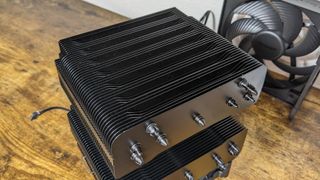
Dark Rock Pro V vs Dark Rock Elite Differences
Because heatsink on both the Dark Rock Elite and the Dark Rock Pro V is the same, the primary difference between these units are the included fans. The only other difference are the tops of the units, with the Elite offering a ring of ARGB illumination.
Packing and Included Contents



Both the Dark Rock Pro 5 and the Dark Rock Elite arrive in identically sized packages. The inner contents are protected by molded foam and cardboard. In addition to the contents around the cooler for protection, there are also foam pieces on the insides of the cooler for protection.
Included with the coolers are the following:
- Two Silent Wings 135mm fans with the Dark Rock Elite
- One Silent Wings 135mm fan, One Silent Wings 4 120mm fan with the Dark Rock Pro V
- Heatsink with seven copper heatpipes
- Mounting for modern AMD and Intel Platforms
- Thermal Paste
- User Manual
LGA 1700 Cooler Installation
The installation of the cooler follows the same process as previous Be Quiet Coolers.
1. You’ll start by assembling the motherboard backplate. Slide the standoffs into the correct position, and secure them using the included rubber rings.
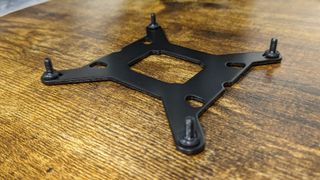
2. Apply the backplate against the motherboard and secure it with the included standoffs.
3. Secure the included mounting bars against the standoffs using the included screws.
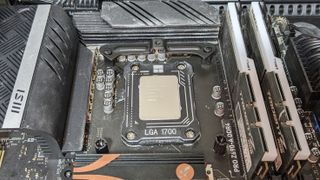
4. Next you’ll need to apply thermal paste to the CPU. If you're unsure how to do that, see our How to Apply Thermal Paste primer.
5. You’ll need to remove the middle fan from the unit before proceeding. Once that’s done, take the heatsink and press it against the mounting bars and secure it with a screwdriver. Reinsert the middle fan, and then set the toggle on the top to your desired operation mode – quiet mode or performance mode.

6. Most users won’t have to remove the outer fan of the Dark Rock Pro V for installation, but if you’re using tall RAM you’ll want to adjust the fan upwards a few notches to avoid compatibility issues. If you have the Dark Rock Elite model, you can simply slide the fan upwards.
7. Place the cover on the top of the unit and connect the headers to your motherboard – installation is complete!

LGA1700 Socket Bending
There are many factors other than the CPU cooler that can influence your cooling performance, including the case you use and the fans installed in it. A system's motherboard can also influence this, especially if it suffers from bending, which results in poor cooler contact with the CPU.
In order to prevent bending from impacting our cooling results, we’ve installed Thermalright’s LGA 1700 contact frame into our testing rig. If your motherboard is affected by bending, your thermal results will be worse than those shown below. Not all motherboards are affected equally by this issue. I tested Raptor Lake CPUs in two motherboards. And while one of them showed significant thermal improvements after installing Thermalright’s LGA1700 contact frame, the other motherboard showed no difference in temperatures whatsoever! Check out our review of the contact frame for more information.
Testing Methodology
Today's highest-end CPUs, whether Intel or AMD, are difficult to cool in intensive workloads. In the past. reaching 95 degrees Celsius or more on a desktop CPU might have been a cause for concern. But with today’s top-end CPUs, this is considered normal operation. Similar behavior has been present in laptops for years due to cooling limitations in tight spaces.
All testing is performed with a 23 degrees Celsius ambient room temperature. Multiple thermal tests are run on each CPU to test the cooler in a variety of conditions, and acoustic measurements are taken with each result. These tests include:
1. Noise-normalized testing at low noise levels
2. Default configuration thermal & acoustics testing
a.) No power limits enforced
b.) Because CPUs hit TJ Max in this scenario (the maximum temperature before throttling), the best way to compare cooling strength is by recording the total CPU package power consumption.
3. Thermal and acoustic testing in power-limited scenarios
a.) Power limited to 175W to emulate a medium-intensity workload
b.) Power limited to 125W to emulate a low-intensity workload
The thermal results included are for 10-minute testing runs. To be sure that was sufficiently long to tax the cooler, we tested both Thermalright’s Assassin X 120 R SE and DeepCool’s LT720 with a 30-minute Cinebench test with Intel’s i9-13900K for both 10 minutes and 30 minutes. The results didn’t change much at all with the longer test: The average clock speeds maintained dropped by 29 MHz on DeepCool’s LT720 and 31 MHz on Thermalright’s Assassin X 120 R SE. That’s an incredibly small 0.6% difference in clock speeds maintained, a margin of error difference that tells us that the 10-minute tests are indeed long enough to properly test the coolers.
Testing Configuration – Intel LGA1700 Platform
| CPU | Intel Core i7-13700K |
| Motherboard | MSI Z690 A Pro DDR4 |
| Case | Be Quiet! Silent Base 802, system fans set to speed 1 setting. |
| Monitor | LG 45GR95QE |
| PSU | Cooler Master XG Plus 850 Platinum PSU |

Albert Thomas is a contributor for Tom’s Hardware, primarily covering CPU cooling reviews.
-
helper800 At this point I think I am going to have to buy Albert the Arctic cooler components I want him to test. The Arctic freezer II 360mm and 420mm AIOs are not on any of the charts unfortunately.Reply -
Albert.Thomas Reply
I have thought about re-testing the LF2 series, but unlike other companies Arctic knows how to count to three ;)helper800 said:At this point I think I am going to have to buy Albert the Arctic cooler components I want him to test. The Arctic freezer II 360mm and 420mm AIOs are not on any of the charts unfortunately.
Maybe I'll have to pull out the LF2 360 at that time :P -
Mike500 Good review about nice coolers. However, one sentence in the Conclusion doesn't quite make sense:Reply
"Trying to decide between the two? I’d advise spending the extra $10 on the Elite model for stronger cooling. Even in the quiet mode it performs better than the Elite."
The Elite performs better than the Elite...? 😉 -
sam buddy @Albert.ThomasReply
The charts are a bit messed up methinks. The CPU package ΔΤ @ 175W chart appears twice under 175W Cinebench Results, while the Noise Levels @ Default Fan Curve chart for the 175W Power Limit also appears under the No Power Limits Thermal Results, probably in place of some other chart.
Thanks for the review and plus one for Arctic cooler reviews. -
Albert.Thomas Reply
It looks like an error occured when they updated the article yesterday, I'll let the editors know ASAP.sam buddy said:@Albert.Thomas
The charts are a bit messed up methinks. The CPU package ΔΤ @ 175W chart appears twice under 175W Cinebench Results, while the Noise Levels @ Default Fan Curve chart for the 175W Power Limit also appears under the No Power Limits Thermal Results, probably in place of some other chart.
Thanks for the review and plus one for Arctic cooler reviews.
Thank you for the report!
